Tuesday, June 1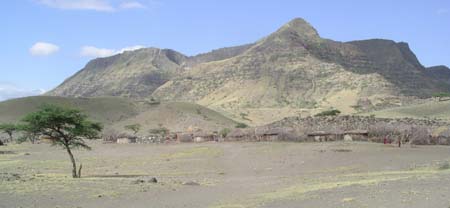
Steve: Our final day camping at Lake Natron brought us some wonderful opportunities to interact with more of the Maasai people, a group that we have become increasingly fascinated with for their unique culture and extremely friendly disposition. We also enjoyed experiencing some of the beautiful scenery of the area.
After a 7:00AM "Jambo, Jambo" (jambo means "hello" in
Swahili and this has become our Tanzanian wakeup call), we had breakfast and
set out for a hike into the gorge here at Lake Natron. Despite this being
the dry season, there is still a good deal of water flowing. The water at
the bottom of the gorge is partially salty due to runoff of various volcanic
minerals that occurs in the streams that feed it. Our final destination was
a large waterfall complete with a natural pool that would prove to be a wonderful
cooling reward for our hike today.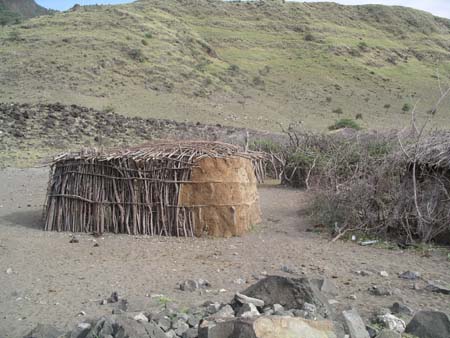
We began by walking by one of the many Maasai bomas that are basically small
neighborhoods. A boma consists of a circle of small homes made of tree branches
and cow dung. The center of the boma serves as a holding pen for cattle that
are kept inside by a fence built from the thorny branches of acacia trees.
This particular boma was brand new, and we could see several of the homes
still being constructed. Some of the cow dung "plaster" was still
wet and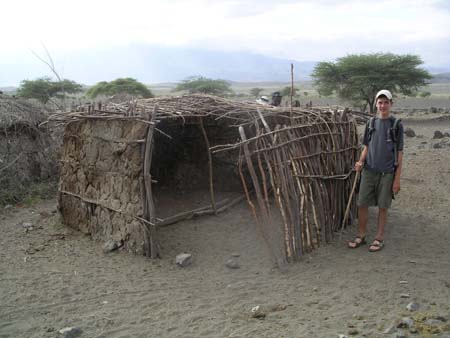 incomplete in several areas. Later in the afternoon we would have an opportunity
to visit another boma and spend time with the families to get a better understanding
of their lives here.
incomplete in several areas. Later in the afternoon we would have an opportunity
to visit another boma and spend time with the families to get a better understanding
of their lives here.
Prior to reaching the gorge, we were serenaded by calls of "hello, hello"
from large groups of children who followed us, along with women carrying bags
of Maasai crafts for sale. Lake Natron is an area frequented by a large number
of tourists each year (this happens to be the beginning of the season, 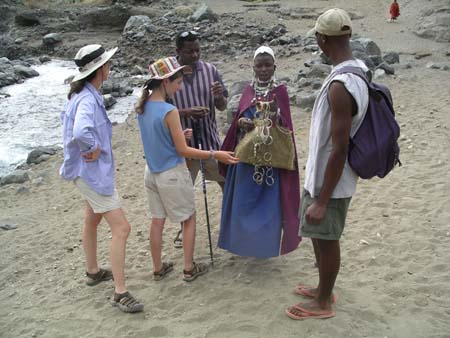 so
we're basically the first ones here), and the local Maasai are well-trained
on how to do business with their visitors. Even the small children take advantage
of the opportunity, speaking a few critical English words and offering to
pose for photos in return for payment.
so
we're basically the first ones here), and the local Maasai are well-trained
on how to do business with their visitors. Even the small children take advantage
of the opportunity, speaking a few critical English words and offering to
pose for photos in return for payment.
Nassibu decided to engage one particular woman who followed us determinedly
in a negotiation for a set of four beaded Maasai bracelets. At first he was
simply having a 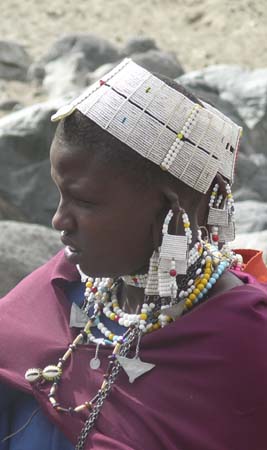 good
time playing with her, but eventually we all stopped and Katie became quickly
involved, further practicing her already fierce negotiating skills. Our first
round ended up in us walking away, unable to bridge the gap between the asking
price of $3.50 and Nassibu's offer (on our behalf) of $3.00 for a set of 4
bracelets. However, we were confident that the woman would be waiting when
we returned from our hike. Sure enough, she
good
time playing with her, but eventually we all stopped and Katie became quickly
involved, further practicing her already fierce negotiating skills. Our first
round ended up in us walking away, unable to bridge the gap between the asking
price of $3.50 and Nassibu's offer (on our behalf) of $3.00 for a set of 4
bracelets. However, we were confident that the woman would be waiting when
we returned from our hike. Sure enough, she 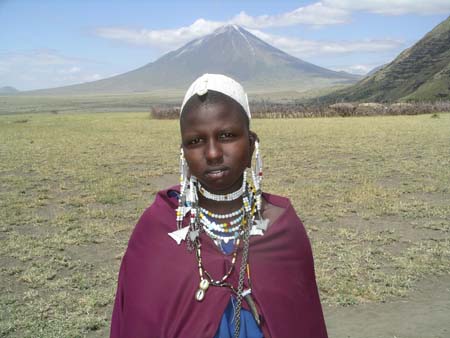 appeared
again during our walk back, and we happily bought our souvenirs making sure
that she knew that for our $3.00 we also expected to be able to also take
some photographs of her. Nassibu jumped right in to pose with the woman in
front of the Langai volcano, but nothing we did could seem to bring
appeared
again during our walk back, and we happily bought our souvenirs making sure
that she knew that for our $3.00 we also expected to be able to also take
some photographs of her. Nassibu jumped right in to pose with the woman in
front of the Langai volcano, but nothing we did could seem to bring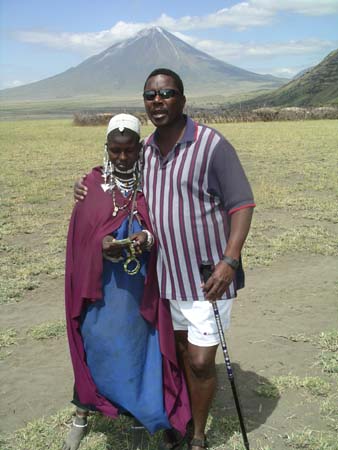 a smile to her face.
a smile to her face.
While the woman was putting a bracelet on David, we took pictures of her
hands adorned with a total of eight rings representing the marriage contracts
that we described a 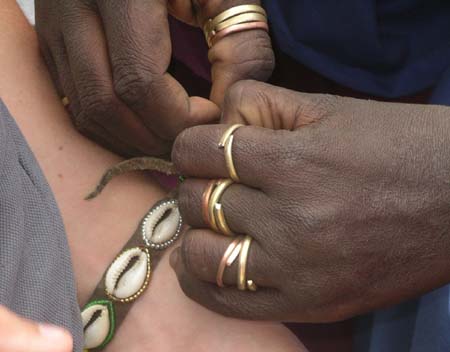 few
days ago. The rings mean that this woman has entered agreements with eight
different men, granting them permission, in first-come-first-served order,
to marry her future eight daughters. Of course, if she doesn't have eight
daughters during her lifetime, then some of these men will miss out. As opposed
to Naiyobi, where the price for a daughter is currently seven cows, the going
dowry here in Lake Natron is anywhere between15 and 20 cows. If this woman
successfully gives birth to even 4 or 5 daughters, she'll become quite wealthy.
In the meantime, being able to exhibit so many rings on her hands is something
of a status symbol, showing that a large number of men desire to marry her
children.
few
days ago. The rings mean that this woman has entered agreements with eight
different men, granting them permission, in first-come-first-served order,
to marry her future eight daughters. Of course, if she doesn't have eight
daughters during her lifetime, then some of these men will miss out. As opposed
to Naiyobi, where the price for a daughter is currently seven cows, the going
dowry here in Lake Natron is anywhere between15 and 20 cows. If this woman
successfully gives birth to even 4 or 5 daughters, she'll become quite wealthy.
In the meantime, being able to exhibit so many rings on her hands is something
of a status symbol, showing that a large number of men desire to marry her
children.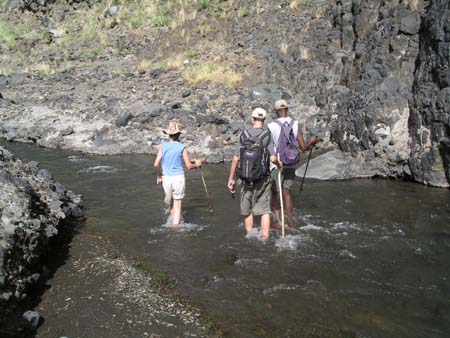
Our hike through the gorge was a wonderful and fun adventure. Justin guided
us up and down steep rocks, and we often had to walk through and across the
river to continue making our way toward the waterfall. Fortunately, the dry
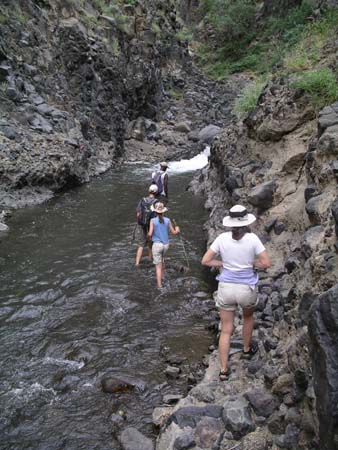 season
has made the height of the river very manageable for walking, but in some
areas we still needed Justin's help in finding the right spots to cross and
his hand in steadying ourselves against the rush of the water.
season
has made the height of the river very manageable for walking, but in some
areas we still needed Justin's help in finding the right spots to cross and
his hand in steadying ourselves against the rush of the water.
The gorge is quite steep and the scenery today was beautiful. Since it's
so early in the season we were also the only ones making this trek today.
As we 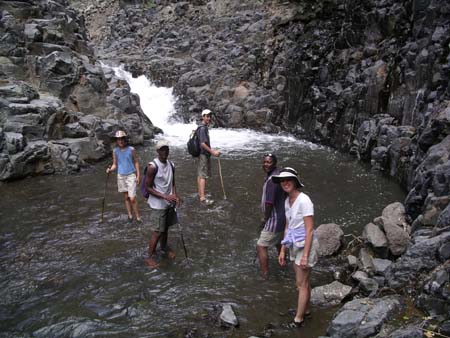 continued,
the water became faster meaning that we were probably nearing our destination.
Finally we rounded a corner and saw the waterfall, a very pretty cascade of
water
continued,
the water became faster meaning that we were probably nearing our destination.
Finally we rounded a corner and saw the waterfall, a very pretty cascade of
water 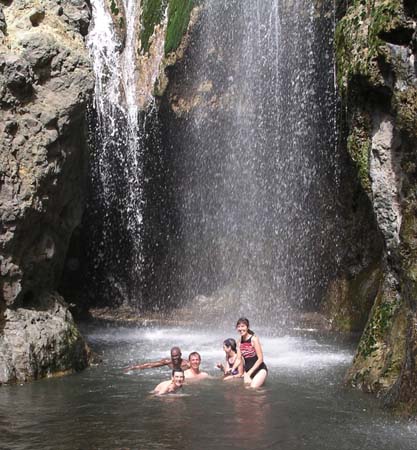 originating
from an unusual grove of palm trees high on the cliff. It didn't take long
for us to all get in and refresh ourselves in the surprisingly warm water
in the pools beneath the falls, and we all enjoyed relaxing and playing in
the water.
originating
from an unusual grove of palm trees high on the cliff. It didn't take long
for us to all get in and refresh ourselves in the surprisingly warm water
in the pools beneath the falls, and we all enjoyed relaxing and playing in
the water.
After hiking back to camp for lunch, we made the short drive to the small
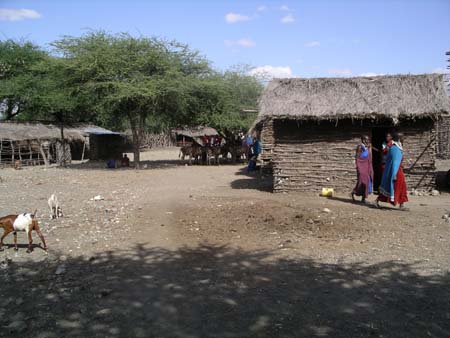 Maasai village of Engarasero, located here at Lake Natron. The entire village
is about the size of a city block, and consists of several small shops, some
homes and a couple of bars. A group of women sitting under a large tree were
selling milk contained in calabashes made from a type of dried gourd. We also
visited the
Maasai village of Engarasero, located here at Lake Natron. The entire village
is about the size of a city block, and consists of several small shops, some
homes and a couple of bars. A group of women sitting under a large tree were
selling milk contained in calabashes made from a type of dried gourd. We also
visited the 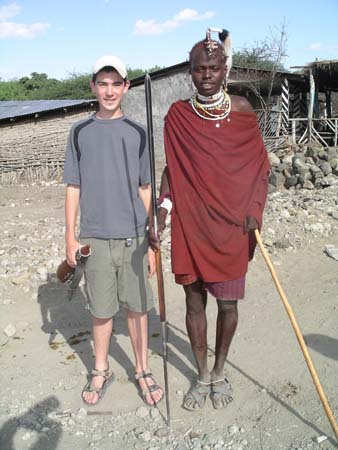 local
butcher, who for a fee will slaughter and barbeque your goat and a small store
where the Maasai can purchase an alcoholic drink made from fermented corn.
local
butcher, who for a fee will slaughter and barbeque your goat and a small store
where the Maasai can purchase an alcoholic drink made from fermented corn.
We came to the village with the intent of buying some authentic souvenirs,
including one of the traditional Maasai spears that the warriors carry, and
also a calabash. The calabash was easy - several of the women offe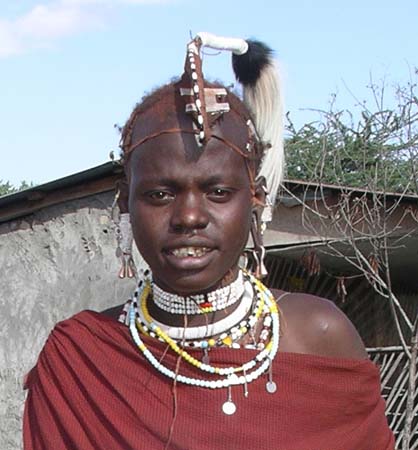 red
to sell us the ones they were using today in the market. For the spear, one
of the warriors in the village originally offered to sell us his for $30.
When we offered him $15, he followed us all around the village finally dropping
his price to $20. We were about to settle on $17 or $18 when another warrior
(pictured here with David) offered us his for $15 and the deal was done.
red
to sell us the ones they were using today in the market. For the spear, one
of the warriors in the village originally offered to sell us his for $30.
When we offered him $15, he followed us all around the village finally dropping
his price to $20. We were about to settle on $17 or $18 when another warrior
(pictured here with David) offered us his for $15 and the deal was done.
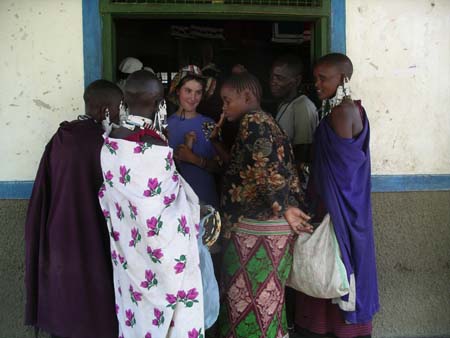 Katie
had a wonderful opportunity to further refine her now ferocious negotiating
skills as she was surrounded by women looking to sell her various pieces of
beaded jewelry. She has learned what having a strong negotiating position
is all about and successfully purchased several souvenirs after an appropriate
amount of haggling with the locals. It's great fun to watch her in action!
Katie
had a wonderful opportunity to further refine her now ferocious negotiating
skills as she was surrounded by women looking to sell her various pieces of
beaded jewelry. She has learned what having a strong negotiating position
is all about and successfully purchased several souvenirs after an appropriate
amount of haggling with the locals. It's great fun to watch her in action!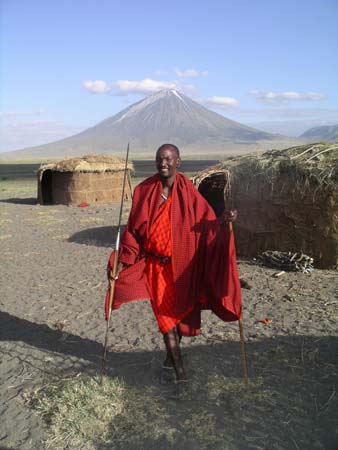
Next was a visit to a local boma that's the home of Marias, a friend of Thomson Safaris back in Watertown. Marias has one wife and three children. The other man who lives in the boma has eight wives, all of whom we met today. Each wife has her own small home in the boma, and their common husband simply decides each night where he is going to sleep. The wives also each own specific cattle (with overall ownership belonging to the man).
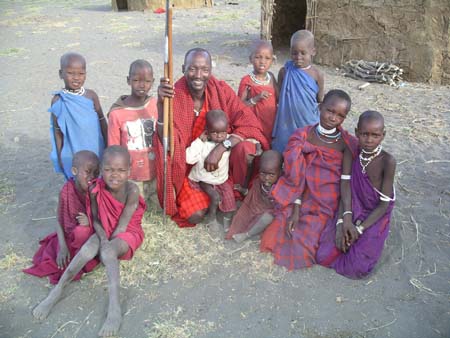 We
counted a total of 24 children in the boma today (there were probably more
that we didn't see), and were told that another seven were out taking care
of the cattle. That means that outside of Marias' family, the other man living
here has fathered at least 28 children across his
We
counted a total of 24 children in the boma today (there were probably more
that we didn't see), and were told that another seven were out taking care
of the cattle. That means that outside of Marias' family, the other man living
here has fathered at least 28 children across his 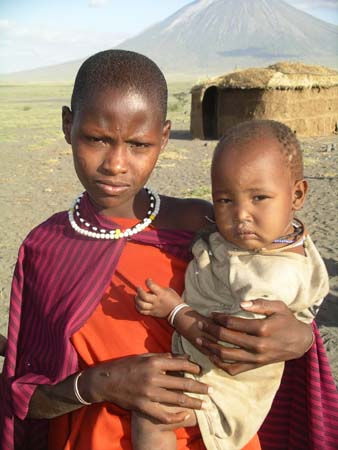 eight
wives. All of the women we saw today had small babies in their arms, and were
also amazed at how many children of similar ages there were. We all joked
about how "busy" this man has been!
eight
wives. All of the women we saw today had small babies in their arms, and were
also amazed at how many children of similar ages there were. We all joked
about how "busy" this man has been!
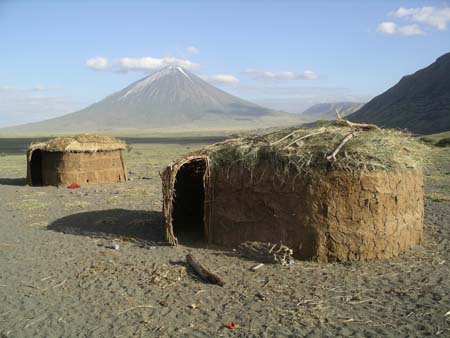 This
boma is very new, and several of the homes are still under construction. In
looking inside several of the homes, it's clear that the Maasai live with
the smallest number of physical possessions out of all the groups we have
visited during our travels. Similar to what we saw in Naiyobi, the homes contain
only a few small bowls and mugs, a dried goat skin that serves as a bed, some
plastic jugs for holding water, and rocks that are used to form a place for
This
boma is very new, and several of the homes are still under construction. In
looking inside several of the homes, it's clear that the Maasai live with
the smallest number of physical possessions out of all the groups we have
visited during our travels. Similar to what we saw in Naiyobi, the homes contain
only a few small bowls and mugs, a dried goat skin that serves as a bed, some
plastic jugs for holding water, and rocks that are used to form a place for
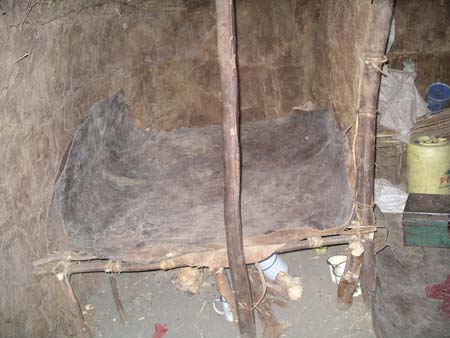 cooking fires. That's it.
cooking fires. That's it.
The women are in charge of building the homes and taking care of the children.
Once boys become eight or nine, they head out to the fields to care for cattle,
goats or donkeys. 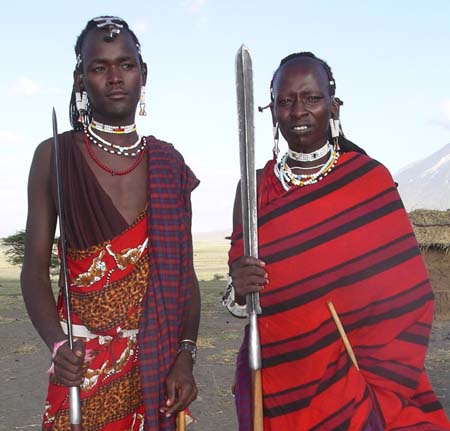 Some
go to school, but many do not. From what we could tell during our visits with
the Maasai, the men have very few responsibilities, other than making sure
that their wives and children are performing their tasks. We were also told
that many of the "elders"
Some
go to school, but many do not. From what we could tell during our visits with
the Maasai, the men have very few responsibilities, other than making sure
that their wives and children are performing their tasks. We were also told
that many of the "elders" 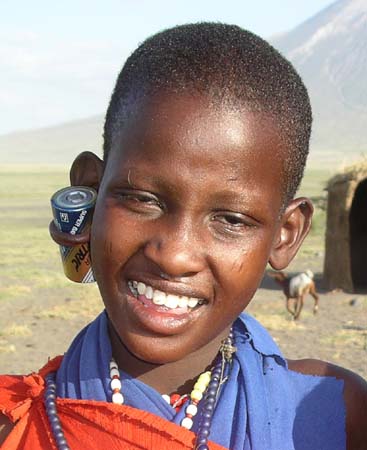 spend
much of their time in the village bars.
spend
much of their time in the village bars.
At the conclusion of our visit, the women all displayed the various crafts
that they have for sale. It was hard for Paula and Katie to decide who to
buy from, but they eventually chose a few things and we 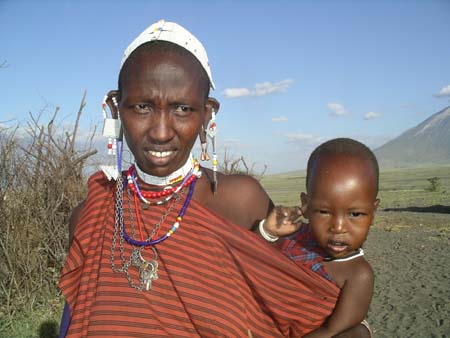 all
said our goodbyes.
all
said our goodbyes.
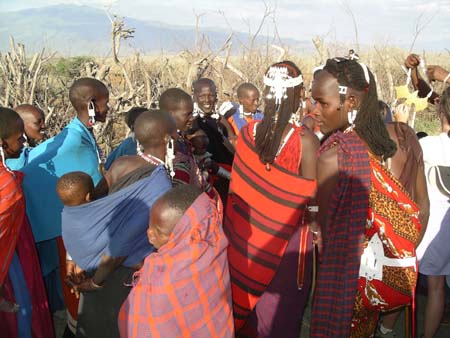
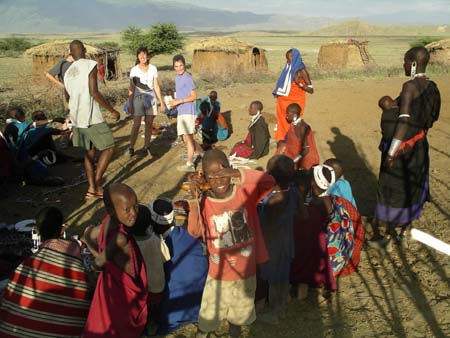
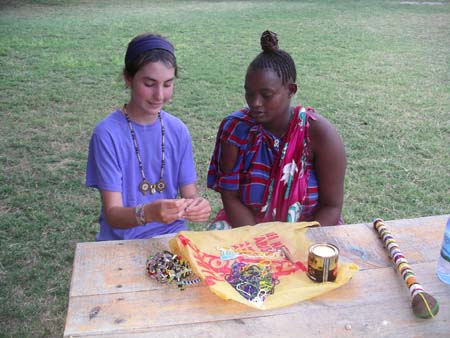
This evening Katie received a lesson in making Maasai beaded jewelry from a woman that we had met in the village. Nassibu arranged for her to come to our camp to give Katie a 30-minute lesson for $1.50. Katie had fun learning about how the jewelry is made, and enjoyed making a small bracelet of her own.
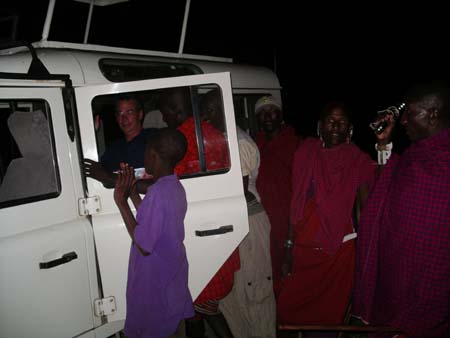 As
we updated our photos on the computer from the day, a group of several Maasai
gathered around with a great deal of curiosity. Most of the people had never
seen a computer, and they laughed and pointed as they saw pictures of their
friends and family members on the screen. David took a picture of some of
them crowded around me in the Land Rover (we have had to use the battery in
the Land Rover to run the computer since there is no electricity in the camps).
As
we updated our photos on the computer from the day, a group of several Maasai
gathered around with a great deal of curiosity. Most of the people had never
seen a computer, and they laughed and pointed as they saw pictures of their
friends and family members on the screen. David took a picture of some of
them crowded around me in the Land Rover (we have had to use the battery in
the Land Rover to run the computer since there is no electricity in the camps).
Tomorrow we'll be leaving the Lake Natron area, and will drive south along the Rift Valley to the E'Unoto resort. Here we plan to spend a half-day relaxing before continuing our adventures in Tanzania.
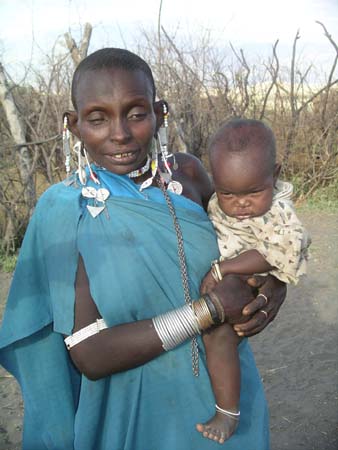
David's Daily Dump: Maasai Marriages. Throughout our safari here in Tanzania, we have been able to visit with Maasai people, and learn about their intriguing culture. One of the things that struck us most about their way of life was how marriages are arranged.
Although we have learned about many different types of arranged marriages, this is by far the most unique and interesting. We discovered that proposals are not made to existing woman, but to unborn girls! Boys sign a contract with a woman saying, for example, that "I will pay you 17 cows if I can marry your fourth daughter" (who is not born yet). If the boy is lucky, he could by married at the age of 20, and if unlucky, over the age of 45!!!
The first thing that I should explain is how men actually acquire wives. For one thing, the Maasai are polygamous, which means that any man can have more than one wife. There are not enough women to go around, so every man relies on luck. The main difference, as I have already mentioned, is that you have to sign a contract with a woman, which promises you one of her future daughters. If you are born into a rich family, your father makes the first agreement with a woman (the boy is usually 2-3 when this happens). The mother is second when the boy is a little older, and then the child is on his own when he is between 8 and 11 years old.
When asking a woman to marry one of her unborn daughters, you must present
to her a ring (usually made of brass) and agree on a dowry (price the boy
pays to marry the girl). At present, the dowry price is fifteen to twenty
cattle, which is much higher than it has been in the past. In total, the boy
may mak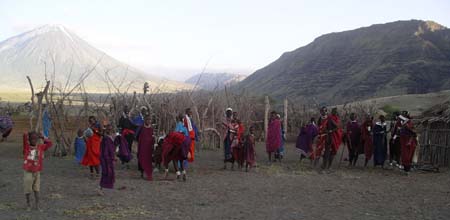 e
anything from 5-20 proposals to guarantee himself at least one wife. Sometimes
you might be the first to ask a woman for a daughter, and sometimes the 8th,
depending on how quick you were. Girls get married at the age of eighteen,
and usually have, more or less, 10 children (some don't survive to become
adults). Again, if a man is lucky, he could get his first wife at the age
of twenty and have more than ten wives, but if unlucky, he may not be married
until he's over forty, and may not even get a wife.
e
anything from 5-20 proposals to guarantee himself at least one wife. Sometimes
you might be the first to ask a woman for a daughter, and sometimes the 8th,
depending on how quick you were. Girls get married at the age of eighteen,
and usually have, more or less, 10 children (some don't survive to become
adults). Again, if a man is lucky, he could get his first wife at the age
of twenty and have more than ten wives, but if unlucky, he may not be married
until he's over forty, and may not even get a wife.
Now you may be asking why it is important to have more than one wife. The
answer is simple: cattle. The more wives you have, the more children you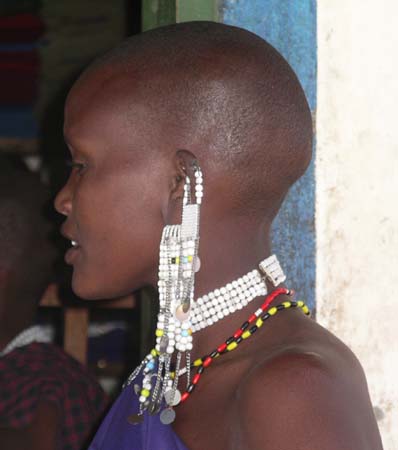 have, the more dowry cows you get in return for your daughters! Having lots
of wives makes you rich and also gives you a high social status, which together
makes you the envy of the village.
have, the more dowry cows you get in return for your daughters! Having lots
of wives makes you rich and also gives you a high social status, which together
makes you the envy of the village.
A good example is our Maasai guide Justin. He made two proposals himself as a boy, but has not even had an existing wife since last year! The women he signed contracts with had many boys and very few girls (he wasn't first in line) He is now twenty five, and is engaged to a one year old girl! It will be seventeen years before he is married, and he will be 42! There is no guarantee that the child will even survive!
Understanding how Maasai marriages actually work has been extremely difficult and hard to comprehend. It is so different from our western style of marriage. Imagine being Justin and watching your infant wife grow up. It's inconceivable for me! But that is just the tradition of the Maasai and the way it has been for hundreds and hundreds of years…
